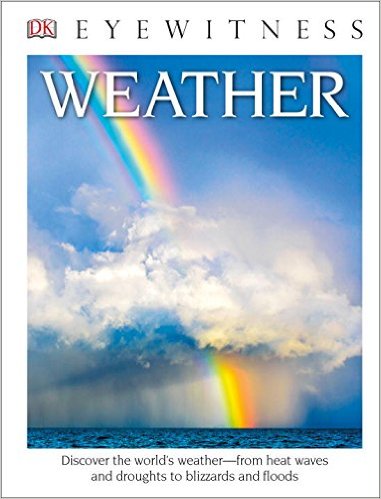I’ve always loved the DK Eyewitness books, and the 2016 edition of Eyewitness Weather certainly is representative of the best of that series. This 72-page book is loaded with full-color illustrations. Each two-page spread has a theme with scattered paragraphs of information on that theme—every paragraph has a related illustration. Illustrated diagrams sometimes show steps in a process.
Text information is very substantial covering the causes of weather, ways to measure weather, weather effects, climate regions and their particular weather patterns, and some historical tidbits on fascinating instruments that were developed in past centuries to measure weather. Some topics headings for the two-page spreads are watching the weather, forecasting, the sun, frost and ice, the birth of a cloud, a rainy day, thunder and lightning, tropical storms, whirling winds, mountains, coastal areas, and climate change. The two-page section on climate change and a brief mention under "Weather Power" are the only places I spotted content that might be debatable—the age of the earth, the extinction of dinosaurs, and causes of global warming. Near the end of the book, there is a two-page primer on creating a home weather station. Instructions are a bit sketchy but it might get you started.
While the book can be read straight through, readers can also dip into topics of immediate interest. Homeschoolers might sometimes select pages to read based on the weather or the time of year.
For homeschoolers, Eyewitness Weather can be used as part of a real-books approach to the study of science or it might be used to supplement another homeschool science curriculum. You might want to use Eyewitness Weather along with something like the Wacky Weird Weather Kit that has experiments and materials for seven activities including recreating weather effects like tidal waves and tornadoes. There are no questions and answers in the book, but creating and maintaining a home weather station might provide worthwhile hands-on work and data recording experience for those who want to combine book learning with a “lab” component.
At first glance, Eyewitness Weather looks identical to the previous edition of the book. However, looking more closely you can see that the text portions of the book have been edited to shorten and simplify some of the information. Even simplified, the information is fascinating and fact-laden enough for adults. While the book is intended for students in the upper elementary grades through junior high, older readers should enjoy browsing through it as well.











